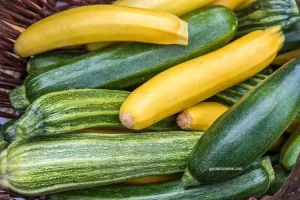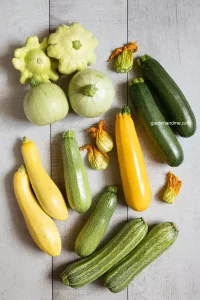The gardener who grows zucchini in your garden can be a rewarding experience. Not only are zucchinis delicious and versatile, but they can also be quite prolific regarding yield. In this article, we will explore the factors thataffect zucchini yield and the ways to harvest the highest zucchini.

Factors that affect how many zucchini per plant do you get?
How many zucchinis do you get from a single plant can vary depending on several factors. These factors include the variety of zucchini you are growing, the growing conditions, and the care provided to the plant.
Well taken zucchini plant.
Some varieties are more prolific than others and can produce a more significant number of zucchinis per plant. Additionally, the overall health and vigor of the plant play an important role in determining the yield. A healthy zucchini plant produces more fruits than a weak or stressed plant. Therefore, you need to make sure your zucchini plants have necessary nutrients and care for optimal yield is essential.
Optimal growing conditions
Zucchini plants need at least 6-8 hours of direct sunlight daily and thrive in full sun. They also prefer well-draining soil that is rich in organic matter. Before planting, it is advisable to amend the soil with compost or well-rotted manure to improve fertility.
Proper spacing is crucial to ensure good airflow and prevent the spread of diseases. Each zucchini you’re growing should be spaced at least 3 to 4 feet apart, allowing ample room for the plant easy to grow and produce individual fruits.
Ideal growing season
Zucchinis are warm-season crops that thrive between 70-85°F (21-29°C). They grow best during the summer months when the weather is consistently warm. Planting zucchinis too early in the spring or too late in the winter when temperatures are cool can result in poor growth and reduced yield.
The impact of frost on zucchini
Frost is detrimental to plant health and can cause severe damage or even death. Protecting young plants from late spring frosts is essential by covering them with frost blankets or using row covers. If ice is forecasted, harvesting any mature zucchinis before the frost arrives is advisable to prevent spoilage.
Extending the growing season
If you live in an area with a short growing season, you can extend the number of zucchini plants can yield by starting seeds indoors and transplanting the seedlings outdoors once all danger of frost has passed. Additionally, techniques like row covers or high tunnels can help create a warm microclimate that allows longer growth and increased zucchini production throughout the season.
Recommended varieties for abundant zucchini production
When selecting varieties for abundant zucchini production, look for those known for their high yield. Some popular types include ‘Black Beauty,’ ‘Costata Romanesco,’ ‘Spineless Beauty,’ and ‘Eight Ball.’ These varieties are known to be vigorous, and you’ll get pounds of zucchinis per plant.
Common problems with zucchini plant growth
Dealing with poor plant growth
Poor plant growth can result from various factors, including inadequate sunlight, nutrient deficiencies, or poor soil quality. Ensure that your zucchini plants receive enough sunlight, provide them with proper nutrients, and amend the soil with compost or organic matter to improve fertility.
Preventing low fruit set in zucchini plants
If your zucchini plants are not getting enough amount of fruit, it could be due to insufficient pollination. Zucchini flowers that want to bloom require pollination to set fruits, and bees or other pollinators typically do this. To enhance pollination, you can hand-pollinate the female flowers using a small brush or Q-tip, transferring pollen between the male and female flowers.
Identifying and managing common pests and diseases
Zucchini plants are susceptible to various pests and diseases, including cucumber beetles, summer squash bugs, powdery mildew, and blossom end rot. Regularly inspect your plants for any signs of pest or disease infestations, and take appropriate measures to control them. This can include using organic insecticides, practicing crop rotation, and maintaining good garden hygiene.
Tips for growing zucchini yield
Good timing to harvest
Knowing when to harvest zucchini is crucial to ensure that you pick them at the optimal stage of ripeness. Zucchinis need to be harvested when they are young and tender, typically 6 to 8 inches long. If left on the plant too long, zucchinis can become oversized and develop tough skins and large seeds.

Frequency of harvesting
During peak season, zucchini plants can produce fruits rapidly. Harvesting zucchini every week, from 1 to 3 days, is recommended to ensure that you pick them at the right size and prevent them from becoming oversized. Regularly harvesting plants also prevents the zucchinis from diverting energy into seed production, promoting continuous fruit production.
Proper technique
When harvesting zucchini, it is essential to use a sharp knife or garden shears to cut the stem cleanly, leaving a small portion attached to the fruit. Avoid twisting or pulling the zucchini off the plant, as this can damage the plant and lead to a reduced yield.
Harvesting zucchinis regularly encourages the plant to produce more fruits. Removing mature zucchinis promptly allows new ones to develop and continue the fruit production cycle throughout the growing season.
Providing adequate sunlight and water
Zucchini plants require full sun to thrive and produce a high yield. Ensure they receive at least 6-8 hours of direct sunlight daily. Adequate water supply is also crucial, especially during hot and dry periods. Water the plants deeply, ensuring the soil stays consistently moist but not soggy.
Importance of regular fertilization for zucchini plants
Regular fertilization is essential to provide the necessary nutrients for plant growth and enhance yield. Before planting, incorporate well-rotted compost or organic matter into the soil to improve fertility. During the growing season, you can feed the plants with a balanced organic fertilizer or use natural amendments like blood meal or rabbit manure.
Controlling pests and diseases to boost zucchini yield
Pests and diseases can significantly impact the yield of zucchini plants. Regularly inspect your plants for common problems like cucumber beetles and squash bugs. If detected, take appropriate measures to control their populations, such as handpicking or using organic insecticides. Additionally, practicing good garden hygiene, including removing any diseased foliage or plants, can help prevent the spread of diseases and ensure healthy plants.
